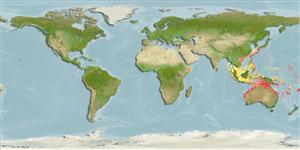>
Callionymiformes (Dragonets) >
Callionymidae (Dragonets)
Etymology: Synchiropus: Greek, syn, symphysis = grown together + Greek, cheir = hand + Greek, pous = foot (Ref. 45335).
Environment: milieu / climate zone / depth range / distribution range
Écologie
marin démersal; profondeur 23 - 75 m (Ref. 86942). Tropical
Western Central Pacific: northwestern Australia and New Caledonia.
Taille / Poids / Âge
Maturity: Lm ? range ? - ? cm
Max length : 15.0 cm TL mâle / non sexé; (Ref. 3132)
Épines dorsales (Total) : 4; Rayons mous dorsaux (Total) : 8; Rayons mous anaux: 7. Head and body light grey, ventrally white, sides with small red blotches and streaks. First dorsal fin yellow or grey, with vertical yellow bars, white spots and streaks edged with black. Second dorsal fin light grey with horizontal yellow and white streaks on posterior half. Caudal fin with 2 wide, vertical, dark grey bars. Anal fin distally black. Preopercular spine with 4 to 11 small antrorse serrae on its dorsal margin and an antrorse spine at its base. First dorsal fin at least twice as high as second dorsal fin. Caudal fin in males without filaments (Ref 42832).
Lives on trawling grounds, often found on sand or rubble bottoms.
Life cycle and mating behavior
Maturities | Reproduction | Spawnings | Egg(s) | Fecundities | Larves
Allen, G.R. and R. Swainston, 1988. The marine fishes of north-western Australia: a field guide for anglers and divers. Western Australian Museum, Perth. 201 p. (Ref. 3132)
Statut dans la liste rouge de l'IUCN (Ref. 130435)
Menace pour l'homme
Harmless
Utilisations par l'homme
Outils
Articles particuliers
Télécharger en XML
Sources Internet
Estimates based on models
Preferred temperature (Ref.
123201): 20.8 - 26.5, mean 24.5 °C (based on 38 cells).
Phylogenetic diversity index (Ref.
82804): PD
50 = 0.5000 [Uniqueness, from 0.5 = low to 2.0 = high].
Bayesian length-weight: a=0.01148 (0.00455 - 0.02896), b=2.92 (2.70 - 3.14), in cm total length, based on LWR estimates for this (Sub)family-body shape (Ref.
93245).
Niveau trophique (Ref.
69278): 3.5 ±0.4 se; based on size and trophs of closest relatives
Résilience (Ref.
120179): Haut, temps minimum de doublement de population inférieur à 15 mois (Preliminary K or Fecundity.).
Fishing Vulnerability (Ref.
59153): Low vulnerability (10 of 100).
